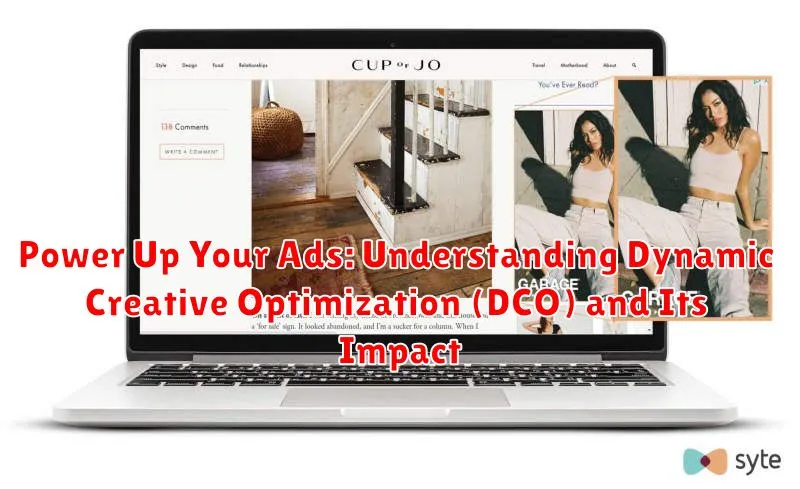In the ever-evolving landscape of digital advertising, achieving optimal campaign performance requires a strategic and adaptive approach. Dynamic Creative Optimization (DCO) emerges as a powerful solution, offering advertisers the ability to personalize ad creatives in real-time based on individual user characteristics and behavior. This introductory guide delves into the intricacies of DCO, exploring its functionality and the significant impact it can have on your advertising endeavors. By leveraging DCO, businesses can move beyond static ad campaigns and embrace a data-driven, personalized approach to reach their target audience effectively and efficiently, ultimately boosting engagement and conversion rates.
This article will dissect the core components of Dynamic Creative Optimization, outlining the process of how it dynamically tailors ad elements such as headlines, images, and call-to-actions to resonate with specific users. We will examine the benefits of implementing DCO, including increased ad relevance, improved click-through rates, and enhanced return on ad spend (ROAS). Furthermore, we will explore real-world examples of successful DCO campaigns and provide practical insights into how you can integrate this powerful technique into your own advertising strategy. Prepare to power up your ads and unlock the potential of personalized advertising with a comprehensive understanding of DCO.
What is Dynamic Creative Optimization (DCO) and How Does It Work?
Dynamic Creative Optimization (DCO) is a sophisticated advertising technology that automatically generates personalized ad creatives in real-time based on data about the viewer. This allows marketers to serve the most relevant ad to each individual, improving engagement and conversion rates.
Here’s a breakdown of how it works:
- Data Collection: DCO platforms gather data about users, including demographics, browsing history, past purchases, and device type.
- Creative Asset Library: Marketers upload various creative assets, such as headlines, images, calls to action, and product details, into the DCO platform.
- Algorithm-Driven Optimization: The DCO platform’s algorithms analyze the user data and select the most appropriate combination of creative assets to display.
- Real-Time Ad Assembly: Based on the algorithm’s selection, the ad is assembled in real-time and displayed to the user.
- Performance Analysis and Learning: The DCO platform continuously monitors the performance of different ad variations and learns which combinations are most effective, refining the creative selection process over time.
In essence, DCO takes the guesswork out of ad creation by leveraging data and automation to deliver highly personalized and effective advertising experiences.
The Core Components of a Successful DCO Strategy
A successful Dynamic Creative Optimization (DCO) strategy hinges on several core components working in synergy. These components ensure ads are not only relevant but also optimized for maximum impact.
Data Integration
First and foremost is data integration. This involves collecting and unifying data from various sources, including CRM systems, website analytics, and third-party data providers. Accurate and comprehensive data fuels the personalization engine of DCO.
Creative Asset Library
Next is a robust creative asset library. This library should contain a diverse range of ad elements, such as headlines, images, calls-to-action, and background colors. The more variations available, the more granular the personalization can be.
Decision Engine
The decision engine is the brain of the DCO system. This component uses algorithms and machine learning to analyze user data and dynamically select the most relevant ad elements for each individual. It continuously learns and adapts based on performance data.
Testing and Optimization
Finally, continuous testing and optimization are crucial. A/B testing different ad variations allows you to identify which combinations resonate best with specific audiences. This iterative process ensures your DCO strategy is constantly improving and delivering optimal results.
Benefits of Using DCO for Personalized Advertising

Dynamic Creative Optimization (DCO) offers substantial advantages for businesses seeking to enhance their advertising efforts through personalization. The ability to tailor ad content to individual users leads to a more engaging and relevant experience, ultimately driving improved campaign performance.
One key benefit is increased engagement rates. By showing users ads that directly address their needs and interests, DCO captures their attention more effectively than generic advertising. This translates into higher click-through rates (CTR) and improved interaction with the ad.
Another significant advantage is improved conversion rates. Personalized ads are more likely to resonate with potential customers, leading to a higher probability of them taking the desired action, such as making a purchase or filling out a form.
Furthermore, DCO enhances ad relevance. By dynamically adjusting ad elements based on user data, DCO ensures that each user sees the most appropriate and appealing message. This heightened relevance contributes to a more positive brand perception and improved customer satisfaction.
Finally, DCO provides valuable data-driven insights. The platform continuously analyzes user behavior and ad performance, allowing marketers to optimize their campaigns for maximum impact and refine their targeting strategies.
Different Types of Dynamic Creative Elements
Dynamic Creative Optimization (DCO) relies on varying ad elements to deliver personalized experiences. These elements can be broadly categorized as follows:
- Dynamic Text: Adjusts headlines, body copy, and calls to action based on user data, such as location, search history, or demographics.
- Dynamic Images: Swaps out images based on user preferences, product availability, or promotional offers.
- Dynamic Offers: Presents different promotions, discounts, or special deals to individual users based on their past behavior or purchase history.
- Dynamic Landing Pages: Directs users to specific landing pages tailored to the ad content and their profile.
- Dynamic Video: Customizes video content to align with individual user preferences or behaviors.
The intelligent combination of these elements enables advertisers to create highly relevant and engaging ad experiences. Consider this example:
Imagine an online retailer using DCO. A user who previously browsed running shoes on their website might see an ad with a dynamic image showcasing the exact running shoe model they viewed. The headline could read: “Still Thinking About Those [Shoe Model Name] Running Shoes?” This level of personalization increases the likelihood of conversion.
Targeting and Segmentation Strategies for DCO Campaigns
Effective targeting and segmentation are paramount to the success of Dynamic Creative Optimization (DCO) campaigns. The goal is to deliver the most relevant ad creative to each individual user, maximizing engagement and conversion rates.
Several segmentation strategies can be employed, including:
- Demographic Targeting: Age, gender, location, income, education level.
- Behavioral Targeting: Past website visits, purchase history, app usage, online activity.
- Contextual Targeting: Matching ads to the content of the websites or apps users are currently viewing.
- Psychographic Targeting: Interests, values, lifestyle, opinions.
- Retargeting: Showing ads to users who have previously interacted with your website or ads.
Data management platforms (DMPs) and customer relationship management (CRM) systems can be integrated to gather and analyze user data, enabling more precise targeting and segmentation. Advanced strategies involve predictive analytics to anticipate user needs and deliver ads that resonate with them.
How to Set Up and Manage DCO Campaigns Effectively
Setting up and managing Dynamic Creative Optimization (DCO) campaigns effectively requires a structured approach. Begin by defining your campaign goals and identifying the key performance indicators (KPIs) you will use to measure success.
Next, select a DCO platform that aligns with your advertising needs and budget. Ensure the platform offers robust creative testing capabilities and seamless integration with your existing advertising ecosystem.
Develop a creative matrix that outlines the various combinations of creative elements you will test. Implement a clear naming convention for your ad variations to facilitate efficient tracking and analysis.
Regularly monitor campaign performance and make data-driven adjustments to your creative elements and targeting parameters. Utilize A/B testing to identify the most effective ad combinations. Maintain detailed records of all changes made to your campaigns for future reference and optimization.
Best Practices for Creating Engaging Dynamic Ads
Creating engaging dynamic ads requires a strategic approach focused on relevance and user experience. Prioritize high-quality visuals that resonate with your target audience. Ensure images and videos are clear, visually appealing, and optimized for different devices.
Craft compelling ad copy that speaks directly to the user’s needs and interests. Use a clear and concise message, highlighting the unique value proposition of your product or service. A/B test different ad copy variations to identify the most effective messaging.
Maintain brand consistency across all dynamic ad elements. Use your brand’s colors, fonts, and logo to create a cohesive and recognizable brand experience. In addition, utilize personalization effectively by using data to tailor offers and promotions that are relevant to individual user preferences and behaviors.
Measuring the Performance of Your DCO Campaigns
Measuring the performance of your Dynamic Creative Optimization (DCO) campaigns is crucial for understanding their effectiveness and optimizing your advertising efforts. By tracking key metrics, you can gain valuable insights into what resonates with your target audience and refine your creative strategies accordingly.
Key performance indicators (KPIs) to monitor include:
- Click-Through Rate (CTR): Measures the percentage of users who click on your ads.
- Conversion Rate: Tracks the percentage of users who complete a desired action (e.g., purchase, sign-up) after clicking on your ad.
- Cost Per Acquisition (CPA): Calculates the cost of acquiring a new customer through your DCO campaigns.
- Return on Ad Spend (ROAS): Measures the revenue generated for every dollar spent on advertising.
Analyzing these metrics allows you to identify high-performing creative variations and audiences, enabling data-driven decisions to improve campaign performance. A/B testing different creative elements and targeting strategies is essential for continuous optimization and achieving your desired advertising outcomes.
Real-World Examples of Successful DCO Implementations

Several companies have leveraged Dynamic Creative Optimization (DCO) to achieve significant improvements in their advertising performance. These examples showcase the power of personalization and relevance in driving conversions and engagement.
E-commerce Retailer: A major online retailer used DCO to tailor ad creatives based on browsing history and past purchases. Customers who viewed specific product categories were shown ads featuring similar items and personalized promotions, resulting in a 30% increase in click-through rates (CTR).
Travel Company: A travel company implemented DCO to display ads showcasing destinations relevant to users’ travel preferences and search queries. By dynamically adjusting imagery, offers, and calls to action, they observed a 20% rise in booking conversions.
Financial Services Provider: A financial institution utilized DCO to target users with personalized messaging about specific financial products based on their demographic data and financial goals. This approach led to a 15% improvement in application submissions.
The Future of DCO: Trends and Innovations
The landscape of Dynamic Creative Optimization (DCO) is continuously evolving, driven by advancements in technology and shifting consumer expectations. Several key trends are shaping its future.
Artificial Intelligence (AI) and Machine Learning (ML) are playing an increasingly vital role. They are enhancing DCO platforms’ ability to analyze vast datasets, predict optimal creative combinations, and automate campaign adjustments in real-time. This leads to improved personalization and efficiency.
Another trend is the growing importance of cross-channel DCO. Brands are seeking to deliver consistent and personalized experiences across various touchpoints, including web, mobile, social media, and connected TV. This requires DCO solutions that can seamlessly integrate with different advertising platforms and data sources.
Privacy-centric DCO is also gaining traction. As consumers become more aware of data privacy, DCO strategies are adapting to prioritize user consent and data minimization while still delivering relevant and engaging ads. Contextual targeting and first-party data are becoming more critical.

